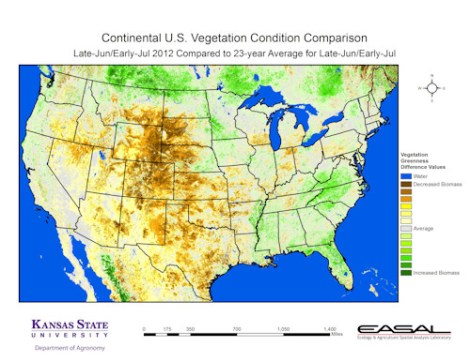
We’re not quite to this point. (Photo from the Library of Congress.)
The Dust Bowl was one of the worst weather-based disasters to ever strike the United States, prompting the largest migration in American history. While the ongoing drought is bad, it’s not Dust-Bowl-bad.
Not yet, anyway.
A report coming out today from the National Climatic Data Center is expected to declare the current drought one of the 10 worst of the past century. Weather.com notes that the percentage of the lower 48 states currently in drought is at 54.6 percent — the sixth-highest since 1895.

The good news is that areas in drought are actually experiencing less severe drought than in the past, as shown below. (“Good” being a very relative term.)

Farm Futures has a series of color-adjusted satellite images comparing the current vegetation conditions with other time periods. Here’s a map comparing the current vegetation condition with the 23-year average for the same time period. The browner the color, the worse the condition. It looks as you might expect.

The impact of this drought on agriculture is tremendous. Farmers in the Midwest are mowing their corn fields, rather than trying to salvage them.
Some cornstalks in fields around the farm where David Kellerman works stand tall, but appearances can be deceiving. When the husks are pulled back, the cobs are empty. No kernels developed as the plants struggled with heat and drought.
The soil in Kellerman’s part of southern Illinois is like dust after less than an inch of rain since mid-April. This week, he and the farmer he works with packed it in. They cut and baled the withered plants to use as hay for their cattle.
As we reported last week, the drought is causing expected corn supplies to drop and, therefore, corn futures to spike.

That increase in corn prices, in turn, means an increase in the price of a lot of other things, including feed for cattle. Some ranchers are preemptively selling hundreds of animals to avoid such price increases.
“If we’re running out of grass and we’re not growing enough feed crops to feed them the other six months of the year, what do you do?” asked R. Scott Barrows, director of Kansas State University’s Golden Prairie District extension office. “You liquidate.”
Make no mistake: The situation is bad. But comparisons to the Dust Bowl tend to underestimate just how disruptive and dangerous that event actually was. It would take much deeper, much more prolonged drought for us to match the Dust Bowl era.
Some consolation for alarmists and Dust-Bowl nostalgics: Climate change means that such droughts may very well be on the way.



